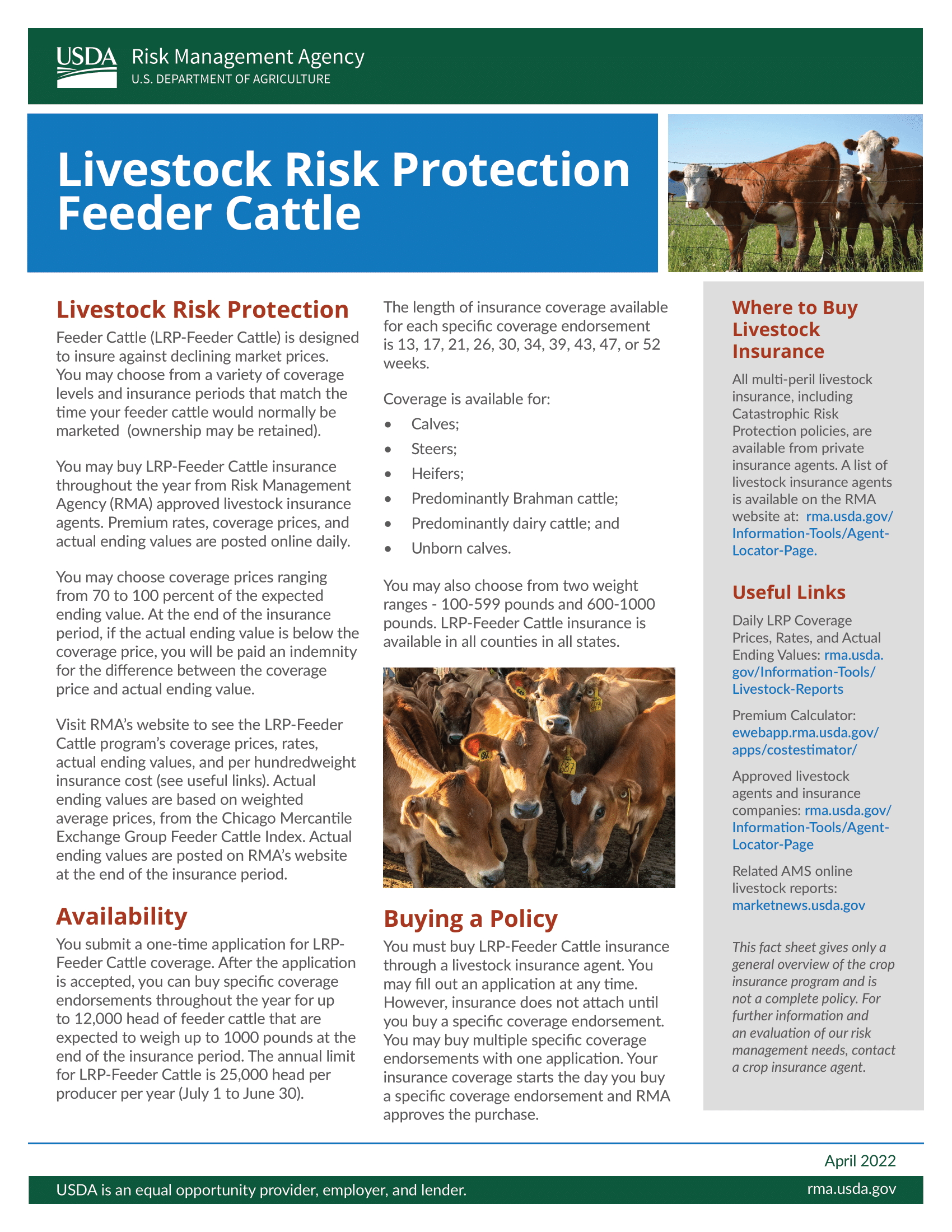Raise Your Knowledge with Bagley Risk Management
Raise Your Knowledge with Bagley Risk Management
Blog Article
Trick Factors to Think About When Picking Livestock Danger Protection (LRP) Insurance Policy
When evaluating alternatives for Livestock Risk Defense (LRP) insurance policy, a number of key elements warrant mindful factor to consider to make sure reliable danger administration in the agricultural market. Selecting the ideal coverage options customized to your certain livestock procedure is vital, as is comprehending exactly how exceptional expenses associate with the level of protection used.
Insurance Coverage Options
When thinking about Animals Danger Security (LRP) insurance coverage, it is essential to understand the numerous coverage options offered to mitigate dangers in the farming market. Animals Threat Protection (LRP) insurance policy provides various protection choices tailored to fulfill the diverse demands of livestock producers.
Another essential insurance coverage choice is the recommendation duration, which establishes the size of time the insurance coverage holds. Manufacturers can select the recommendation duration that finest suits their manufacturing cycle and market problems. Additionally, coverage levels and rates differ based on the sort of animals being insured, offering manufacturers the adaptability to customize their insurance policy prepares according to their details demands.
Understanding the various insurance coverage options readily available under Animals Risk Defense (LRP) insurance policy is important for manufacturers to make educated decisions that successfully protect their animals operations from market unpredictabilities.
Costs Expenses

Animals Threat Defense (LRP) insurance policy gives essential protection choices customized to alleviate threats in the farming market, with a considerable element to take into consideration being the estimation and structure of premium expenses. When figuring out premium expenses for LRP insurance coverage, numerous variables enter into play. These include the type and number of animals being guaranteed, the coverage level selected, the present market rates, historic cost data, and the length of the protection period. Insurance providers might additionally think about the location of the ranch, as geographical elements can influence the total threat profile.
Premium costs for LRP insurance are normally calculated based on actuarial data and run the risk of evaluation designs. Insurance companies evaluate historic information on animals prices and manufacturing costs to figure out an appropriate costs that shows the degree of threat entailed. It is essential for livestock producers to meticulously review premium expenses and protection alternatives to ensure they are effectively shielded against potential monetary losses because of damaging market problems or unanticipated events. By comprehending exactly how exceptional prices are computed and structured, manufacturers can make informed decisions when choosing the best LRP insurance coverage for their procedure.
Eligible Animals
The decision of qualified animals for Livestock Risk Security (LRP) insurance policy coverage includes careful factor to consider of specific requirements and features. Animals types that are typically eligible for LRP insurance coverage include feeder livestock, fed cattle, lambs, and swine.
Feeder livestock, for instance, are generally eligible for LRP insurance coverage if they fall within specified weight ranges. Lambs are one more group of animals that can be considered for LRP insurance, with factors such as weight and age playing a crucial role in establishing their eligibility.
Before picking LRP insurance policy for livestock, producers need to thoroughly examine the qualification standards described by the insurance coverage copyright to ensure their animals fulfill the essential needs for coverage.
Policy Flexibility
Policy flexibility in Animals Threat Protection (LRP) insurance coverage permits manufacturers to tailor coverage to match their certain requirements and risk management strategies. This flexibility encourages livestock manufacturers to customize their insurance policy plans based on factors such as the kind of animals they own, market problems, and individual threat tolerance degrees. By supplying adjustable options, LRP insurance coverage enables manufacturers to efficiently handle their risk direct exposure while securing their livestock operations versus unforeseen market volatility.
Cases Process
Upon experiencing a loss or damage, manufacturers can launch the cases process for their Animals Danger Security (LRP) insurance policy by without delay calling their insurance policy provider. It is vital for manufacturers to report the loss as quickly as feasible link to speed up the claims process. When reaching out to the insurance coverage copyright, manufacturers will need to provide comprehensive details concerning the case, including the day, nature of the loss, and any type of pertinent paperwork such as veterinary documents or market value.

After the evaluation is total, the insurance service provider will certainly choose concerning the claim and interact the result to the manufacturer. If the claim is accepted, the producer will certainly obtain payment according to the terms of their Animals Danger Security (LRP) insurance coverage policy. Bagley Risk Management. It is crucial for producers to be accustomed to the insurance claims process to guarantee a smooth experience in case of a loss
.png)
Conclusion
In conclusion, when choosing Animals Threat Security (LRP) insurance coverage, it is important to think about insurance coverage choices, premium costs, qualified animals, policy you could try here flexibility, and the insurance claims procedure. These crucial factors will aid guarantee that herdsmans and farmers are properly secured versus possible dangers and losses related to their animals procedures. Making an educated decision based upon these considerations can eventually cause better financial safety and security and peace of mind for animals producers.
Livestock Risk Protection (LRP) insurance policy provides various insurance coverage options tailored to meet the diverse requirements of animals producers.The determination of qualified animals for Animals Danger Security (LRP) insurance coverage involves mindful factor to consider of particular requirements and qualities.Policy adaptability in Animals Danger Security (LRP) insurance allows producers to customize insurance coverage to fit their particular requirements and run the risk of administration approaches.Upon experiencing a loss or damages, producers can start the insurance claims process for their Animals Threat Defense (LRP) insurance policy by without delay calling their insurance supplier.In final thought, when selecting Livestock Danger Defense (LRP) insurance coverage, it is crucial to think about protection alternatives, premium prices, eligible livestock, policy flexibility, and the cases look at this website process.
Report this page